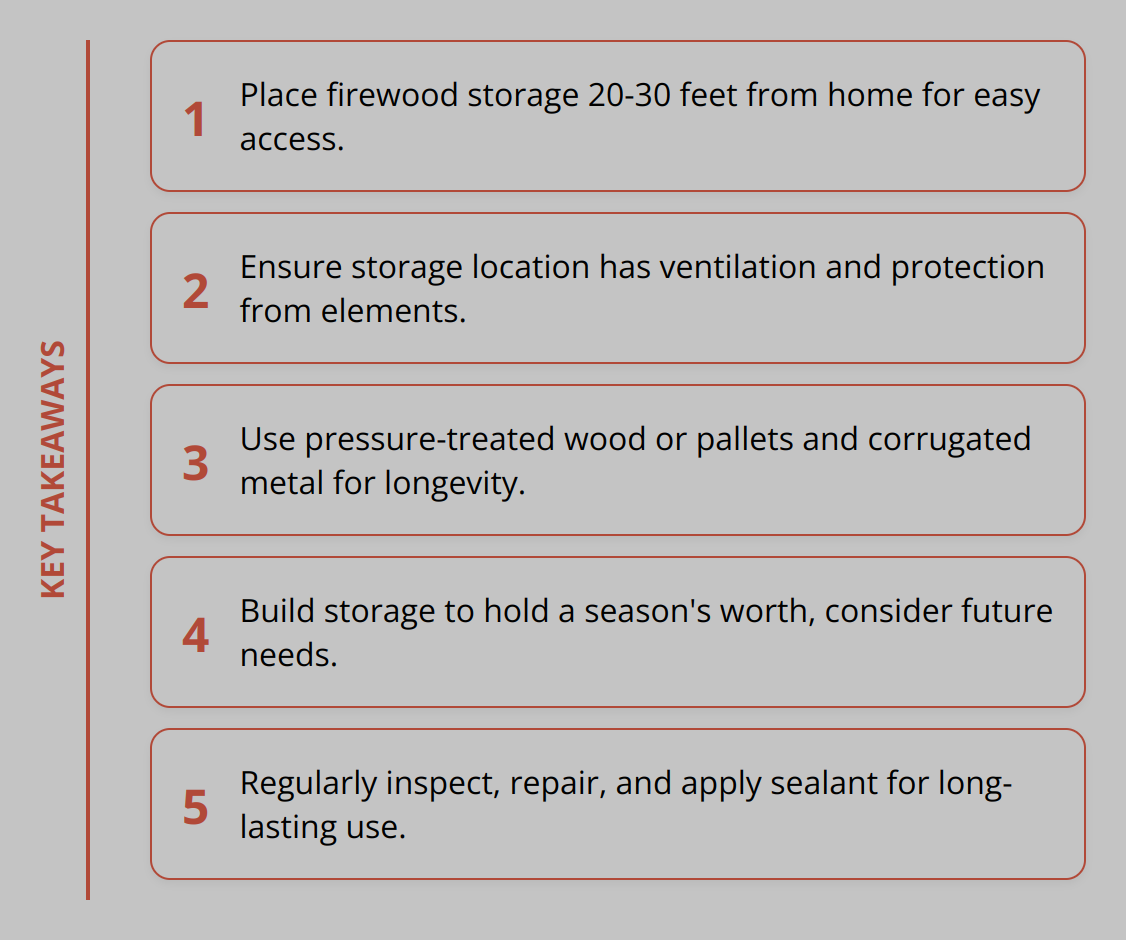
At S&S Fire Pits, we understand the importance of efficient firewood storage for enhancing your outdoor experiences. Proper storage not only keeps your wood dry but also ready for those spontaneous gatherings around the fire pit.
In this guide, we offer practical advice on how to design, build, and maintain your own firewood storage, ensuring your fuel is in the best condition for creating memorable moments. Join us as we explore simple yet effective strategies for DIY enthusiasts.
Choosing Firewood Storage Location
When setting up a firewood storage solution, pinpointing the perfect spot is not just about convenience. It’s crucial for wood preservation, easy access, and safety. The ultimate goal is to have wood that burns efficiently, providing warmth and ambiance without hassles. Here’s what matters most:
Easy Access is Key: You want your firewood close enough to your home or fire pit for easy retrieval, especially during chilly evenings. However, too close, and you risk pests entering your dwelling. A sweet spot exists about 20 to 30 feet away from your home. This distance strikes a balance between convenience and safety, keeping pests at bay while ensuring your wood is easily accessible.

Ventilation Can’t Be Overstated: Fresh air circulation is paramount for preventing mold and promoting proper seasoning of your firewood. Choose an area with good airflow. Avoid tightly enclosed spaces or the leeward side of buildings where moisture can trap. Instead, consider an open or semi-open space where air can move freely around your woodpile.
Shielded from the Elements: While complete outdoor exposure can hinder proper wood seasoning, a little protection goes a long way. Opt for a location with a natural shield against rain and snow, like under the eave of a building or beneath a canopy of trees. However, ensure the spot still benefits from sunlight and breeze to aid in drying the wood.
Consider these additional tips for optimal placement:
- Observe your property during different weather conditions to identify areas that stay dry and receive ample sunlight.
- If using a storage structure, position it to take advantage of prevailing winds for increased air circulation.
- Elevate your woodpile off the ground on a pallet or rack, like the ones we offer at S&S Fire Pits, to avoid moisture from the ground and improve airflow.
- Make periodic adjustments based on seasonal changes; what works in summer might not be ideal in winter.

By carefully selecting where you store your firewood, you’ll not only extend its usable life but also ensure it’s ready when you need it, burning cleanly and efficiently every time. Always remember, the key to a great fire starts long before the match is struck—it begins with how and where you store your wood.
Designing Your Firewood Storage
When it comes to creating your own firewood storage, selecting the right materials, planning for the right size and capacity, and building for durability are vital to ensure your wood stays dry, accessible, and ready to use. Here are some actionable insights and recommendations to guide you through the process.
Selecting the Right Materials
The longevity of your firewood storage hinges significantly on the materials you choose. Pressure-treated wood stands out for its resistance to rot and pests, making it an excellent choice for the frame and base. For a more budget-friendly option, pallets can be repurposed as a solid foundation, ensuring your woodpile is elevated off the ground. When considering roofing materials, corrugated metal offers durability and excellent protection from the elements, ensuring your wood stays dry.

Planning for Size and Capacity
Understanding your wood consumption habits is essential in determining the size of your storage. A general rule is to build a storage that can hold at least a season’s worth of wood. For an average household, this could range from 3 to 5 cords of wood. Creating a storage solution that is too small leads to frequent restocking, while too large a storage could take up unnecessary space and resources.
Build your storage with future needs in mind. If you anticipate using your fire pit more frequently in the coming years or if you plan to use wood as a primary heating source in your home, consider scaling up your storage capacity accordingly.
Tips for Enhancing Durability
- Elevate the base: Keeping your wood off the ground not only prevents moisture absorption but also deters pests. Using concrete blocks or metal stands can provide a sturdy and durable foundation.
- Protect against the elements: Applying a wood preservative or sealant to all wooden components of your storage can extend its life. Consider adding a tarp cover during the wet season for additional protection, ensuring it’s designed for breathability to prevent mold growth.
- Ensure proper air flow: Design your storage to allow air to circulate freely through the woodpile. This means not packing the wood too tightly and including spaces between the rows of wood. Proper ventilation speeds up the drying process and keeps the wood in optimal burning condition.

Building a firewood storage might seem like a straightforward project, but these considerations ensure that your effort results in a practical, durable, and efficient storage solution. By selecting the right materials, right-sizing your storage, and focusing on durability-enhancing techniques, your firewood will be well-protected, seasoned, and ready to fuel your fire pit gatherings.
For further reading on maintaining your firewood, check out our how to season firewood guide.
Building and Upkeeping Firewood Storage
Creating a functional firewood storage space requires a strategic approach right from the assembly to its maintenance. Diving into the specifics not only guarantees the longevity of your storage solution but also ensures your firewood remains in the best condition for use. Let’s explore the essential steps and tips for assembling your firewood storage and keeping it in top-notch condition.
Step-by-Step Assembly Guidance
Building your firewood storage starts with a solid plan and the right tools. First and foremost, gather all necessary materials, including pressure-treated lumber for the frame, corrugated metal for the roof, and hardware for assembly. Precision in measuring and cutting materials is key to creating a stable structure. Follow these steps for a smooth assembly process:
- Layout: Mark your ground where the storage will sit. Ensure the area is level; this may require some minor excavation or the addition of gravel.
- Foundation: If elevation is needed, place concrete blocks at each corner. This prevents direct contact with the ground, reducing moisture wicking.
- Frame Construction: Assemble the frame using pressure-treated lumber. Secure corners and joints with high-quality exterior screws for durability.
- Roof Installation: Attach corrugated metal sheets to the top of the frame for waterproofing. Ensure a slight overhang to direct water away from the woodpile.
- Cross Ventilation: Integrate spaces between boards and ensure gaps in the storage design for air to circulate freely.
Remember, the goal is to build a structure that withstands the elements and keeps firewood dry and accessible. Paying attention to details during assembly pays off in the utility and durability of your firewood storage.
Maintaining Your Firewood Storage for Longevity
Routine maintenance ensures your firewood storage remains effective and extends its lifespan. Seasonal checks and minor adjustments can prevent larger issues down the line:
- Inspect and Repair: Regularly examine your storage for signs of wear, such as loose screws or rotting wood, and make necessary repairs promptly.
- Preserve Wood: Apply a wood preservative or sealant to the storage annually to protect against rot and insect damage.
- Tarp Cover: In wet seasons, cover your woodpile with a breathable tarp to protect it from rain and snow. Secure the tarp to allow for airflow and prevent mold.
- Pest Control: Keep the area around your firewood storage tidy and free of debris to discourage pests. Consider natural repellents or a professional pest control service if necessary.
Seasonal Preparation and Pest Control
To keep your firewood dry and ready for use year-round, seasonal preparation is essential. Before the wet or cold seasons set in, ensure your woodpile is covered and raised off the ground. This not only prevents moisture but also makes it less attractive to pests. Control measures might include elevating your woodpile further off the ground or applying natural deterrents around the storage area.
In summary, building and maintaining a firewood storage structure is not just about creating a place to stack wood. It’s about ensuring the quality and readiness of the wood for when those chilly nights call for a cozy fire. With these practical tips on assembly and maintenance, your firewood storage will serve you well, supporting countless hours of enjoyment around your fire pit.
For more hands-on advice on maintaining outdoor spaces, visit landscape maintenance tips.
Final Thoughts
We’ve walked through the essential steps to design, build, and maintain effective firewood storage. Here’s a brief recap of the key points to ensure your firewood is always ready for those special moments around the fire.

- Location is vital: Choose a spot that balances convenience with the need for dry, well-seasoned wood.
- Materials matter: Use durable, moisture-resistant materials like pressure-treated wood and corrugated metal.
- Size and capacity: Build according to your needs, considering both current and future wood consumption.
- Ventilation and protection: Ensure your design allows for air circulation and is shielded from the elements.
- Routine maintenance: Regular checks and upkeep are necessary to prolong the life of your firewood storage.
Building your own firewood storage is not just a project; it’s a step towards self-sufficiency and the satisfaction of preparing for those warm, memorable gatherings. It’s about taking control of your outdoor living space and making it truly yours.
We at S&S Fire Pits encourage you to dive into this project with enthusiasm. Not only is it practical, but it also compliments the experience of using one of our handcrafted, solid steel fire pits, guaranteed for life and designed to bring people together.
We’d love to hear about your DIY adventures, successful builds, and any personal tips you’ve discovered along the way. Sharing your experiences can help inspire others to embark on their own projects, fostering a community of outdoor enthusiasts who take pride in their creations.
Let’s keep the spirit of outdoor enjoyment alive, ensuring our gatherings are lit with perfectly seasoned wood from storages built with our own hands. Here’s to many more nights under the stars, by the fire, surrounded by friends and family.


